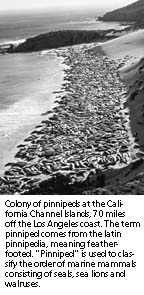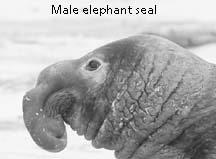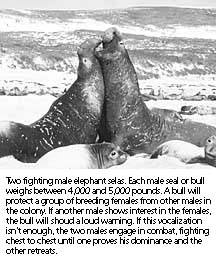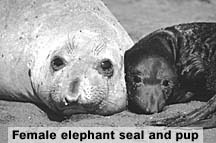






Where do the elephant seals go?
Seals and sea lions are such a fixture of life along the coast that
it's surprising how little we know about their movements. Researchers at
Hubbs-Sea World are starting to fill in the picture, with some amazing findings.
by Katy Koster
 f you've spent much time on California beaches, chances
are you've seen seals and sea lions, playing in the surf or basking on the
rocks. The truth is, these ubiquitous mammals spend substantial periods
at sea each year, but their whereabouts and behaviors are relatively unknown.
f you've spent much time on California beaches, chances
are you've seen seals and sea lions, playing in the surf or basking on the
rocks. The truth is, these ubiquitous mammals spend substantial periods
at sea each year, but their whereabouts and behaviors are relatively unknown.
Scientists at the Hubbs-Sea World Research Institute are trying to change
that. Using the latest in satellite technology, they have been studying
the diving behaviors and foraging migrations of northern elephant seal bulls
for the past several years.


 California sea lions and northern elephant seal populations
have increased substantially along the California coast during the past
several decades. The sea lion's increase has been quite apparent to sport
and commercial fishermen, and more recently each winter, to those living
along the coast of Washington, where the marine mammals have invaded the
waterways of Puget Sound to feast on migrating salmon. Near Pier 39 in San
Francisco and in Monterey Bay, large numbers of male sea lions have hauled
out and caused damage on private boat docks and fuel barges.
California sea lions and northern elephant seal populations
have increased substantially along the California coast during the past
several decades. The sea lion's increase has been quite apparent to sport
and commercial fishermen, and more recently each winter, to those living
along the coast of Washington, where the marine mammals have invaded the
waterways of Puget Sound to feast on migrating salmon. Near Pier 39 in San
Francisco and in Monterey Bay, large numbers of male sea lions have hauled
out and caused damage on private boat docks and fuel barges.
Return of the elephants
 The rapid repopulation of California's waters by northern
elephant seals has been much less conspicuous, however, attracting only
minor public attention. Commercial hunters exterminated northern elephant
seals from California waters in the l9th Century - not until the 1950s did
elephant seals return to the Southern California Channel Islands to breed.
The rapid repopulation of California's waters by northern
elephant seals has been much less conspicuous, however, attracting only
minor public attention. Commercial hunters exterminated northern elephant
seals from California waters in the l9th Century - not until the 1950s did
elephant seals return to the Southern California Channel Islands to breed.
 Today, San Miguel Island, lying about 70 miles west
of Los Angeles, hosts the world's largest northern ele-phant seal colony.
Seals congregate there in winter to breed and again in the spring and summer
to molt, but they are rarely seen during the ten months or so when they
are at sea. Indeed, their whereabouts for most of their lives are unknown.
Today, San Miguel Island, lying about 70 miles west
of Los Angeles, hosts the world's largest northern ele-phant seal colony.
Seals congregate there in winter to breed and again in the spring and summer
to molt, but they are rarely seen during the ten months or so when they
are at sea. Indeed, their whereabouts for most of their lives are unknown.
 In 1987, Hubbs scientists began studying the diving
behaviors and foraging ecologies of elephant seals at San Miguel Island.
They document the depths and duration of the seals dives, the amount of
time seals spend resting at the surface between dives, and the sequential
patterns of dives.
In 1987, Hubbs scientists began studying the diving
behaviors and foraging ecologies of elephant seals at San Miguel Island.
They document the depths and duration of the seals dives, the amount of
time seals spend resting at the surface between dives, and the sequential
patterns of dives.



Hi-tech tracking
 To track the seals, the scientists employ small electronic
instruments called time-depth recorders (TDRs). The original TDRs were large
devices, about 6 by 8 inches in size and weighing over 2 pounds. The newest
units are much improved, consisting of a 6-inch long cylinder about 1 1/2
inch in diameter. The TDR's are glued to the hair of seals just before they
leave the rookeries in late February. The housings for the TDRs must be
pressure-tolerant to protect the unit at depths to which seals were diving
- 1,500 to 2,500 feet, with the deepest recorded dive to about 5,000 feet.
To track the seals, the scientists employ small electronic
instruments called time-depth recorders (TDRs). The original TDRs were large
devices, about 6 by 8 inches in size and weighing over 2 pounds. The newest
units are much improved, consisting of a 6-inch long cylinder about 1 1/2
inch in diameter. The TDR's are glued to the hair of seals just before they
leave the rookeries in late February. The housings for the TDRs must be
pressure-tolerant to protect the unit at depths to which seals were diving
- 1,500 to 2,500 feet, with the deepest recorded dive to about 5,000 feet.
 The TDRs provide information in two ways. First, the
unit records and stores data internally. The unit is retrieved when the
seals return to San Miguel Island in July to molt, and the data is dumped
for analysis. Second, the unit is able to send a small amount of data to
a satellite in polar orbit when the animal surfaces to breathe. The satellite
then retransmits the data to a ground station in France, and on to a computer
terminal at the Institute's headquarters on Mission Bay. Scientists can
determine the whereabouts of an animal in the middle of the Pacific Ocean
within minutes of that transmission.
The TDRs provide information in two ways. First, the
unit records and stores data internally. The unit is retrieved when the
seals return to San Miguel Island in July to molt, and the data is dumped
for analysis. Second, the unit is able to send a small amount of data to
a satellite in polar orbit when the animal surfaces to breathe. The satellite
then retransmits the data to a ground station in France, and on to a computer
terminal at the Institute's headquarters on Mission Bay. Scientists can
determine the whereabouts of an animal in the middle of the Pacific Ocean
within minutes of that transmission.
 Adult male elephant seals dive continuously while at
sea for periods of 120 to 150 days in spring and early summer; it is a rare
event for a seal to spend more than five minutes at the surface between
dives that average 25 minutes. Because of limitations of previous satellite
systems, this pattern of infrequent and brief surface activity has made
it difficult to provide detailed movement information. However, recent improvements
in satellite technology now allow scientists to get locations of pelagic
(open sea) animals as well as dive duration and dive-depth measurements.
Adult male elephant seals dive continuously while at
sea for periods of 120 to 150 days in spring and early summer; it is a rare
event for a seal to spend more than five minutes at the surface between
dives that average 25 minutes. Because of limitations of previous satellite
systems, this pattern of infrequent and brief surface activity has made
it difficult to provide detailed movement information. However, recent improvements
in satellite technology now allow scientists to get locations of pelagic
(open sea) animals as well as dive duration and dive-depth measurements.

 On the road
On the road
 Analysis of the data gathered details some astounding
movements. Although routes differ slightly, northern elephant seals travel
north to the Gulf of Alaska and the Aleutian Islands in approximately 40
days. They forage there for another 40 - 50 days, then take 40 - 50 days
to return to San Miguel Island. Elephant seals can cover more than 5,000
miles during annual migrations.
Analysis of the data gathered details some astounding
movements. Although routes differ slightly, northern elephant seals travel
north to the Gulf of Alaska and the Aleutian Islands in approximately 40
days. They forage there for another 40 - 50 days, then take 40 - 50 days
to return to San Miguel Island. Elephant seals can cover more than 5,000
miles during annual migrations.
 Diving patterns reveal uninterrupted diving for four
to five months. The records suggest that the seals forage continuously (diving
to depths of about 1,500 feet) during north- and southbound transits. Their
infrequent and brief surface appearances, as well as their offshore distributions
when at sea, explain why so few elephant seals have ever been seen away
from land-based breeding and molting sites despite their rapidly growing
numbers.
Diving patterns reveal uninterrupted diving for four
to five months. The records suggest that the seals forage continuously (diving
to depths of about 1,500 feet) during north- and southbound transits. Their
infrequent and brief surface appearances, as well as their offshore distributions
when at sea, explain why so few elephant seals have ever been seen away
from land-based breeding and molting sites despite their rapidly growing
numbers.
 Institute studies were the first to document the pelagic
distribution and movements of northern elephant seals and demonstrated the
utility of this technology for studying the migrations and foraging ecologies
of marine mammals in general.
Institute studies were the first to document the pelagic
distribution and movements of northern elephant seals and demonstrated the
utility of this technology for studying the migrations and foraging ecologies
of marine mammals in general.
 Studies are also conducted to examine annual variability
in foraging migrations and the extent of overlap in distributions of males
and females while at sea. Adult males and females separate - for reasons
as yet unknown - during two annual migrations covering 10,000 - 12,000 miles
each year.
Studies are also conducted to examine annual variability
in foraging migrations and the extent of overlap in distributions of males
and females while at sea. Adult males and females separate - for reasons
as yet unknown - during two annual migrations covering 10,000 - 12,000 miles
each year.
 Information gained from Institute research provides
baseline data for sound ecology and conservation programs, and may provide
the foundation for legislation and environmental management decisions that
protect oceanic resources for generations to come.
Information gained from Institute research provides
baseline data for sound ecology and conservation programs, and may provide
the foundation for legislation and environmental management decisions that
protect oceanic resources for generations to come.

Katy Koster, a San Diego resident since 1985, lives in Normal Heights
and works in Public Relations at Hubbs-Sea World Research Institute, a non-profit
marine research foundation. The information in this report is based primarily
on the work of Dr. Brent Stewart.









